Earth 7 - Dinosaurs
1/109
Earn XP
Description and Tags
Midterm prep
Name | Mastery | Learn | Test | Matching | Spaced |
|---|
No study sessions yet.
110 Terms
Paleontology
The scientific study of fossils, which provides unparalleled insights into prehistoric life, evolution, and myriad other topics.
Scientific Method: four steps
Observe
Hypothesize
Predict
Test Predictions
Falsifiability
Hypotheses and the predictions scientists make must be vulnerable to being proven wrong.
Igneous Rocks
Form from melts (magma, lava) that cool and solidify. Only rarely preserve fossils (ash). We can often determine their ABSOLUTE ages.
Metamorphic Rocks
Underwent heating or pressure during their history, changing everything about them. Formed in places where rocks get carried to great depths (like seduction zones). Usually destroys any fossils that were in the rocks before pressure was applied (but rarely fossils can be found in them).
Sedimentary Rocks
Form from eroded pieces of other rocks (sediments) that accumulate in low lying areas. Sediments often bury organisms, preserving their remains. As sediments become rock, these remains become fossils. Often we can determine the RELATIVE ages of these rocks (not the absolute ages because that would just reveal the age of the sediments making up the larger rock).
Fossil
Any evidence of ancient life. Form and are found with the following steps: Death → decay → burial → lithification → erosion. Two types: body and trace.
Body fossil
part of an organism (i.e. a tooth, limb, or whole specimen)
Trace fossil
evidence of an organism’s activity; evidence of an organism modifying its environment (i.e. a trackway, footprint, coprolite (fossilized feces), eggs, nests, burrows)
Lithification
Turning into rock (going from loose sediment to one rock)
Permineralization (Fossilization)
minerals fill in empty pore spaces in bones
Replacement (Fossilization)
new minerals replace original phosphate; the minerals already in the bone get replaced by new minerals, transforming it into something that can be preserved
Coprolite
Fossilized feces; example of a trace fossil
Relative dating
the age of rocks compared to other rocks
Absolute dating
the age of rocks in years
Relative Dating Principles
Original horizontality
Superposition
Faunal Succession
Superposition
Strata formed by the accumulation of rock particles, oldest are on the bottom and youngest on top. Rocks are deposited in a chronological sequence. Part of Relative Dating.
Faunal Succession
Always the same sequence. Each group of organisms lived during a discreet time interval. This order is preserved in the rock record (ex: rabbits always appear after T. Rex). Thus fossils give us a sense of the relative age of rocks.
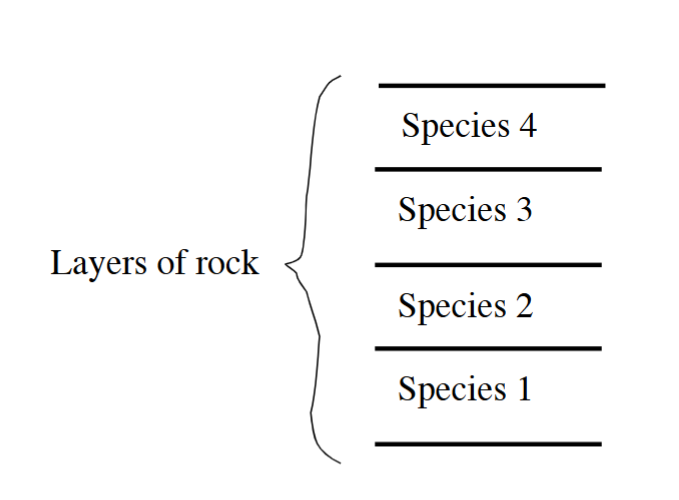
Original horizontality
Sedimentary rocks are deposited horizontally. If they are seen vertically now, they have been deformed by the earth’s crust. Part of relative dating.
Uniformitarianism
Physical processes observed today operated in the geological past. Modern processes help us unravel ancient events. Slow processes acting over vast timespans have helped shape earth’s surface on immense scales.
Biostratigraphy
Using fossils to correlate rocks and determine their ages
Lithostratigraphy
Correlating rock types (sandstone with sandstone)
Simplified atomic structure
Each element has a specific number of protons.
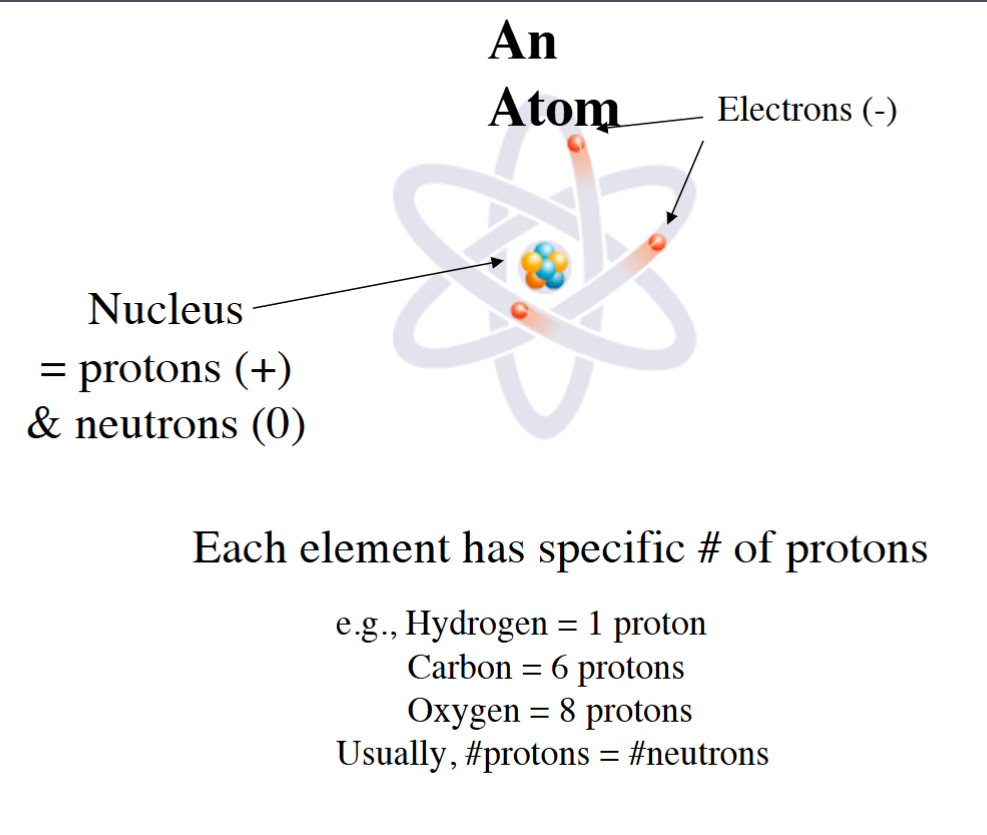
Isotopes
Variants of the same element that have different numbers of neutrons. 2 kinds: Stable, Unstable
Radioactivity
Spontaneous changes (decay) in/of the structure of unstable atomic nuclei. Some isotopes are stable and others are unstable and break down over time. The break down is referred to as radioactivity.
Unstable Isotopes
Radioactive decay. One element (parent) will change into another (daughter) with more stable configuration.
Parent
unstable radioactive isotopes
Daughter Product
isotopes resulting from the decay of a parent
Half-life
The time required for one-half of the radioactive parent in a sample to decay into its daughter product. After one of these, half of the parent material will be represented. Usually an exponential decay process.
Darwin’s ideas
Common Descent with Modification; Natural selection
Common descent with modification
All living organisms are related, descending from a single common ancestor
Natural Selection follows from three observations
Variation in a species; Different survival and reproduction; Heritability of Variation
Differential Survival and Reproduction
Often brutal in nature; some individuals have more offspring than others because their traits allow them to survive.
Heritability of Variation
Variation genetically controlled; Offspring resemble parents (exhibit similar variations); Certain traits will be eliminated and the species will move away from that trait because they stand out to a predator or some other cause of death. The survivors’ traits will live on and be inherited.
Cladograms
phylogeny or evolutionary tree; attempt to show the relationship between organisms
Taxa
single species or groups of species; represented by branches on a cladogram
Nodes
where branches join on a cladogram; represent the last common ancestor of those taxa; the hypothetical most recent common ancestor of everything that stems from that branch point. These are pivotal branch points on the evolutionary diagram.
Sister groups
The branches stemming from the same node; also known as closest relatives
pruning
a way to simplify cladograms; You can combine branches like this only when the more inclusive category that you form is a clade (or monophyletic taxon) that includes all of the descendants of a common ancestor
Evolutionary Novelties
Defining character, derived character, advanced character, diagnostic feature/character = the same thing as this; a novel character that other organisms lack, derived from a common ancestor
Homologous Characters
similar because they were inherited from common ancestor (ex: Arms, legs, fins, and wings in these groups are superficially different, but their unequivocal underlying similarity is indicative of their shared ancestry)
Convergent Characters
Similarities not inherited from a common ancestor (independently acquired); ex: Last common ancestor of butterflies and birds lacked wings. Wings arose independently.
Secondary Loss
A feature was developed and then a species lost that feature. An evolutionary novelty appeared and then was lost later. Ex: Snakes are tetrapods, their ancestors had limbs, but they lost those limbs later
Paraphyletic groups
Ancestor + SOME descendants = BAD (artificial, incomplete branch on evolutionary tree); A group that includes an ancestor and some but not all of its descendants
Monophyletic Groups (aka Clades)
Include ancestor + ALL descendants = GOOD (real/natural, complete branches on evolutionary tree)
Oldest clear evidence of life
Fossil Stromatolites; Bacterial body fossils (sulphate reducers?)
Fossil Stromatolites
Layered colonial structures or rocks; Formed in shallow waters as microorganisms (cyanobacteria) trap sediment → microbial mats! preserved from 3.5 million years ago
Bacterial body fossils
single celled organisms that were preserved; preserved from 3.5 million years ago
The Great Oxidation
Several lines of evidence for influx of O2 into atmosphere/oceans around 2.5 Ga; Some argue that Cyanobacteria photosynthesized to push higher O2 levels into the atmosphere
Cyanobacteria
formed stromatolites; the ONLY organisms to ever “invent” the ability to photosynthesize and produce oxygen.
3 Domains of Life
Bacteria, Archaea, Eukarya
Endosymbiosis
how organisms went from prokaryotes to eukaryotes; Aerobic bacteria became incorporated into an ancestral eukaryotic cell, becoming the mitochondria. at the same time, photosynthetic bacterium was engulfed in these protoeukaryotes and they became the chloroplasts
“Snowball Earth” Global Glacinations
earth became completely covered in ice at the end of the Precambrian (even the oceans froze over)
Paleozoic Era
Begins with an explosion in animal diversity; Plants and vertebrates transition to land; Beginning: Cambrian, End: Permian
Mammals
Generally small-sized in Mesozoic. Ecologically diverse, but not dominant. Diversify rapidly in the Cenozoic.
Cambrian Radiation of animals
includes first vertebrates; Most animal body plans appear in the fossil record near the base of the Paleozoic
Cambrian
earliest slice of time after Precambrian; start of the paleozoic
Arthropods
Include crustaceans, trilobites, insects, and arachnids. They are the most diverse of all animal groups (making up ~80% of all animal species alive).
Vertebrate
a large group of animals distinguished by the possession of a backbone or spinal column
Gnathostomes
Vertebrates with jaws; “Jaw Mouths”
Gill arches
Used for filter feeding and respiration; later evolved into the bones of the jaw
Chondrichthyes
Sharks, rays, skates, chimeras; “Cartilage fish"; Because their skeletons are not ossified, they are very rare in the fossil record
Osteichthyes
Ray-finned “fish,” fleshy-limbed vertebrates; characterized by more bone in the skeleton and air sacks (like lungs)
Ray-finned “fish”
Actinopterygii; These fish have little needles of bone running from the ends of the fins to the body wall
Fleshy-limbed Vertebrates
Sarcopterygii; They have flesh and muscle at the bases of their limbs/fins
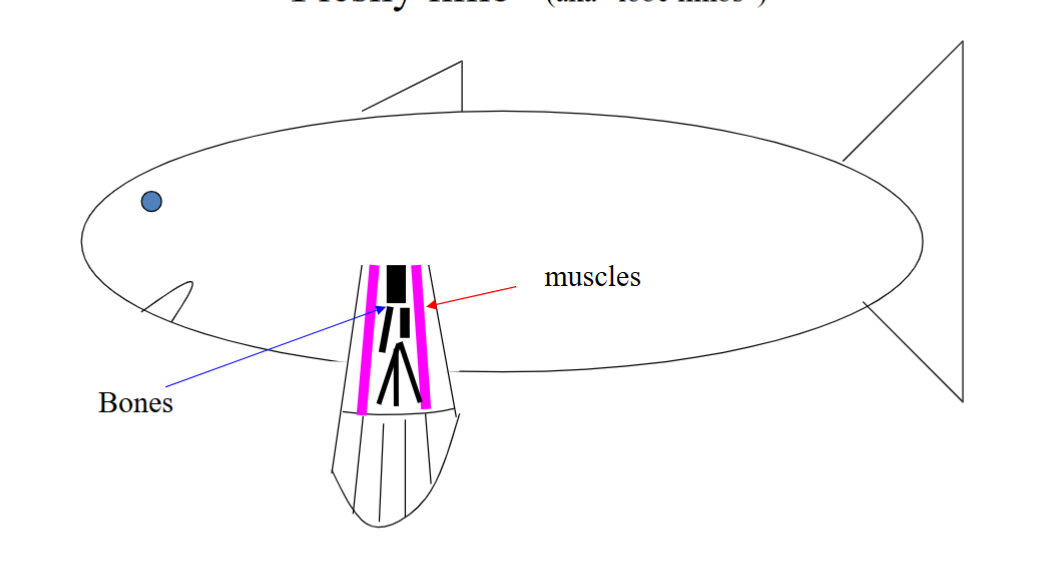
Tetrapods
Four-limbed vertebrates with fingers that can walk on land; Four limbs with fingers; Vertebrae with struts; Robust hips; Stapes
Four Robust Limbs
with digits; used in locomotion & grasping; a tetrapod novelty
Vertebrae with struts
helps keep the backbone rigid on land, since weight is no longer supported by the water; tetrapod novelty
Robust hips
attach to the spine, supporting more weight; firm skeletal connection between hind limb and vertebral column; tetrapod novelty
Stapes
Sound doesn’t travel as efficiently in the air as in water, so this bone connects the eardrum to the inner ear, to help transmit sounds; touches the eardrum and the opening of the inner ear to help transfer sound; tetrapod novelty
Seeds
The evolution of these was related to new modes of fertilization that did NOT require water; help prevent desiccation; allow plants to germinate under ideal conditions; allowed plants to become more fully terrestrial
Amniotes
Synapsids and reptiles; evolutionary novelties: Amniotic Egg, Internal fertilization, Waterproof skin, Complex lungs
Amphibious
animals spent much if not most of their lives in water (with short excursions to land); tied to water for reproduction and early development; use metamorphosis
Metamorphosis
the process undergone by developing amphibians as they go from fertilized eggs to fully developed animals
Amniotic egg
self-contained egg with membranes of various functions (like the amnion, which is the membrane that holds the water and embryo developing in the water); an amniote evolutionary novelty
Internal Fertlization
as opposed to spawning, amniotes deliver sperm directly into the mother (a consequence of the self-contained egg); an amniote evolutionary novelty
Spawning
releasing sperm and eggs directly into water
Waterproof Skin
Keeps amniotes from desiccating; minimizes water loss and allows animals to live away from water
Mesozoic
Beginning: Triassic, Middle: Jurassic, End: Cretaceous. End-Permian Extinction occurred right before this era.
Complex lungs
an amniote evolutionary novelty; allowed amniotes to take in more oxygen to fill their increased energy requirements from being active and living on land
Eukaryotes
organisms with an advanced cell structure, including a nucleus, organelles (like the mitochondria) and chloroplasts (where photosynthesis takes place)
Anapsid
a skull condition with no temporal fenestrae. This is an ancestral condition (i.e., early tetrapods and early amniotes had this condition)
Reptiles
Evolutionary Novelty: B-keratin scales; two types: early anapsid and diapsid
Diapsids
Have two temporal fenestrae; includes: turtles (secondary loss of temporal fenestrae), “lizards” & kin, and archosaurs; fenestrae developed convergently
Synapsids
One temporal fenestra; mammals included in this category; fenestra developed convergently
Archosaurs
Includes: crocodiles & kin, Pterosaurs, and Dinosaurs. Evolutionary novelties: Thecodonty, Antiorbital fenestrae, Mandibular fenestrae, Parental care
Thecodonty
the roots of the teeth completely encircled by bone; convergent with mammals; an archosaur evolutionary novelty
Antiorbital fenestra
a hole (fenestra) in the front part of the skull, just anterior of the eye; not seen in crocodiles or other current archosaurs; an archosaur evolutionary novelty
Mandibular fenestra
a hole (fenestra) in the lower jaw; an archosaur evolutionary novelty
Parental care
animals with this generally invest a lot of time in incubating eggs or hanging out near their nest then providing nourishment to their young; an archosaur evolutionary novelty (developed convergently from mammals)
End-Permian extinction
Earth’s most severe extinction event; ~80% of all marine species went extinct, ~70% of all terrestrial vertebrate species became extinct; between the Permian (Paleozoic) and Triassic (Mesozoic); caused by formation of Pangea and Volcanic eruptions
Formation of Pangea
Contributed to the End-Permian extinction; lowered the sea level, changed weather patterns, created more dry land, removed some shallow marine environments
Volcanic eruptions
Contributed to the End-Permian extinction; Siberian traps flood basalts ~250 Ma. 3-4 million km^3 of lava - enough to cover Earth in 20+ ft of basalt all in Siberia
Ornithodires
Dinosaurs and Pterosaurs; running adaptations including Mesotarsal ankle and Digitigrade stance
Mesotarsal ankle
All motion takes place between the tarsals; The tibia and fibula are attached to the ankle bones, making a hinge-like motion; an ornithodire evolutionary novelty
Digitigrade stance
ankles are held off the ground and they walk on their digits; Only digits and phalanges strike the ground; an ornithodire evolutionary novelty
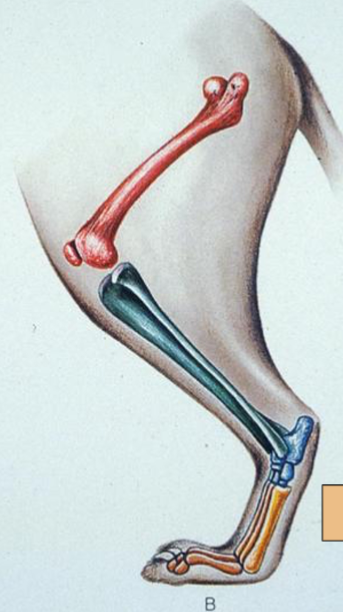
Plantigrade stance
ankle bones strike the ground during a step. Digits on ground.
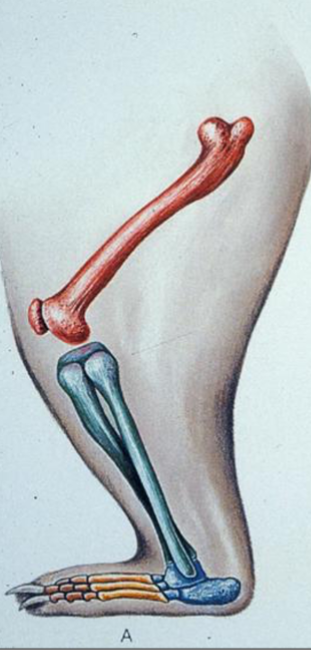
Unguligrade stance
walking on the tip of one's digits (i.e. hooved animals)
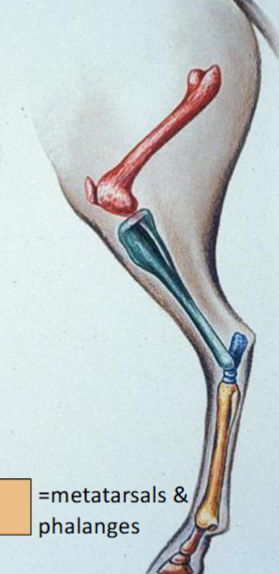
Pterosaurs
“Winged lizard”; most of the wing comes off of 1 elongated finger bone; a type of ornithodire
Dinosaurs
Evolutionary Novelties: Erect posture and narrow-tracked gait (including the following morphological change: opening in hip socket bordered by a bony upper ridge (lip) Upright Femur, Femur with inturned head); an ornithodire